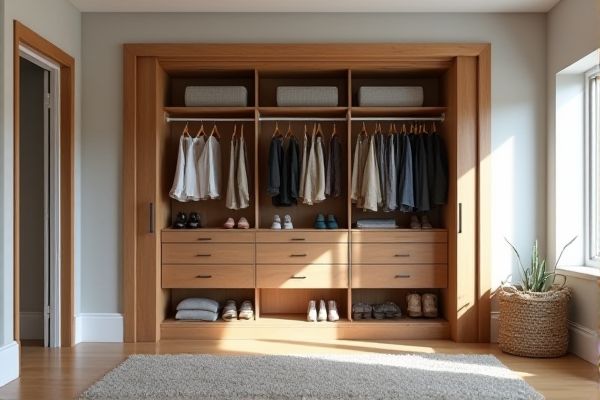
An open closet offers easy visibility and accessibility, making it ideal for showcasing your wardrobe and saving space, while an enclosed closet provides better protection from dust and a more organized, tidy appearance. Discover the key differences and which option suits Your lifestyle best by reading the rest of the article.
Table of Comparison
| Feature | Open Closet | Enclosed Closet |
|---|---|---|
| Accessibility | Easy and quick access | Requires opening doors |
| Visibility | Full visibility of clothes | Clothes hidden behind doors |
| Space Utilization | Maximizes room space | May consume more space |
| Dust Protection | No protection; clothes exposed to dust | Protects clothes from dust and dirt |
| Aesthetics | Modern, minimalistic look | Neat and organized appearance |
| Cost | Generally less expensive | Usually more costly |
| Maintenance | Requires frequent cleaning | Lower cleaning frequency |
Understanding Open Closets: Definition and Features
Open closets feature an exposed design without doors or walls, allowing easy access and visibility of your clothing and accessories. These closets often include hanging rods, shelves, and sometimes drawers, enhancing organization while maximizing room airflow. Your choice of an open closet can add a modern, spacious feel to your room but requires consistent tidiness to maintain aesthetic appeal.
What Is an Enclosed Closet? Key Characteristics
An enclosed closet is a storage space fully surrounded by walls or doors, providing complete concealment of its contents and protecting clothes from dust and light exposure. Key characteristics include solid doors--often sliding or hinged--that create a defined boundary, fixed or adjustable shelves, and hanging rods tailored for organized garment storage. This design enhances bedroom aesthetics and helps maintain clothing quality by limiting environmental factors.
Aesthetic Appeal: Comparing Open and Enclosed Closets
Open closets enhance aesthetic appeal by showcasing clothing and accessories as part of the room's decor, creating a visually dynamic and personalized atmosphere. Enclosed closets offer a tidier and more streamlined look, concealing clutter and maintaining a minimalist design that complements modern interiors. The choice between open and enclosed closets significantly impacts room aesthetics depending on preferences for display versus concealed storage.
Space Optimization: Which Closet Saves More Room?
Open closets maximize space by eliminating doors and bulky frames, allowing for easier access and flexible storage solutions such as adjustable shelves and hanging rods. Enclosed closets, while providing protection from dust and a more polished appearance, require additional clearance for door swings or sliding mechanisms, which can reduce usable floor space. In terms of space optimization, open closets typically save more room, especially in small or irregularly shaped areas, by utilizing vertical space efficiently and minimizing structural constraints.
Organization and Accessibility in Closet Designs
Open closets provide easy access and immediate visibility to clothing, enhancing daily outfit selection and maintaining an organized appearance with minimal barriers. Enclosed closets protect items from dust and light, allowing for a more controlled environment but often require extra effort to keep contents orderly and accessible. Optimal closet design balances open shelving for frequent items with enclosed sections for offseason apparel, maximizing both organization and accessibility.
Maintenance and Cleaning: Open vs Enclosed Closets
Open closets require frequent dusting and organizing since their contents are always exposed to air and dust particles. Enclosed closets provide better protection against dirt, insects, and moisture, reducing cleaning frequency and preserving clothing quality. You can minimize maintenance efforts by choosing an enclosed closet with proper ventilation and sealed doors.
Privacy and Security: Pros and Cons of Each Style
Open closets offer easy access and visibility, making outfit selection quicker but compromising on privacy and security, as belongings are exposed to everyone in the room. Enclosed closets, with doors or panels, provide greater privacy by concealing your items and protecting them from dust and unauthorized access, enhancing security for valuable possessions. Your choice between open and enclosed closets depends on whether you prioritize accessibility or safeguarding your belongings.
Cost Differences Between Open and Enclosed Closets
Open closets generally cost less than enclosed closets due to fewer materials and simpler construction requirements. Enclosed closets involve expenses for doors, framing, and finishing touches, which increase the overall investment. You can save money by opting for an open closet design without sacrificing basic storage functionality.
Which Closet Suits Your Lifestyle? Factors to Consider
Open closets offer easy access and visibility, making them ideal for those who prefer a minimalist, frequently changing wardrobe and prioritize convenience. Enclosed closets provide better protection from dust and light, suited for storing delicate or seasonal items and maintaining a tidier appearance. Your choice depends on factors like space availability, organization preferences, and how you balance aesthetics with functionality.
Final Verdict: Choosing the Right Closet for Your Home
Open closets provide easy access and visual organization, ideal for small spaces and minimalistic interiors, while enclosed closets offer better protection from dust and a cleaner look, preferred in traditional or formal settings. Consider factors such as room size, design aesthetic, and storage needs to make an informed decision that enhances functionality and complements your home's style. Prioritize convenience and maintenance when selecting between open and enclosed closet solutions.
 homyna.com
homyna.com